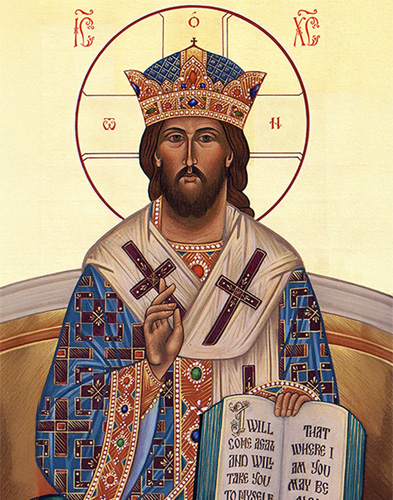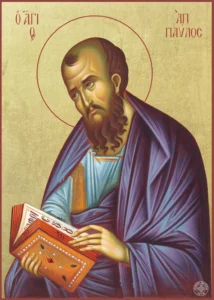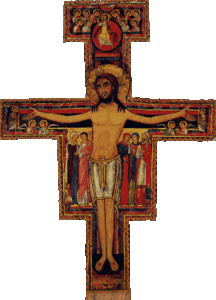The Apostle Saint Paul teaches: He has indeed qualified us as ministers of a new covenant (2 Cor 3:6). We already saw that the Catholic priest is a minister; let us now see what it means to be a minister of the New Covenant.
The covenant expresses the relationship between God and His chosen people.
It implies election, which is the initial and permanent action that assures a singular relationship between God and His people; the covenant “is at once the form and the content”[1] of that election.
It constitutes them as a particular people.
A. Its Name
Different words are used to name that singular reality of the relationship of God with His people:
- in Hebrew: בךית (berith)
- in Greek: διαθήκη (diathéke, used by the Septuagint)
- in Latin: foedus, testamentum, pactum
- in English: covenant, testament, pact. It is also called law, insofar as it is “the expression of the covenant”[2] and “the conditions of the covenant.”[3]
The etymology of the word berith is uncertain. The most prob- able is that it derives from a root brh which means to tie (some re- late the word to the Assyrian birtu, meaning bond, and biritu, meaning tie).
There is no need to be astonished at the complexity of this topic, or at how much the authors vary in their opinions, because in all languages the word for covenant, pact, or testament means many things:
- The matter of the pact
- The symbol with which the covenant is made
- The action of agreeing and making the pact[4]
B. What Types of Covenant Were There Historically?
We find that the Book of the Covenant, or Bible, is divided into two large parts: the Old Testament or Covenant, and the New Testament or Covenant, and these parts have a relationship or continuity between them, related as what is imperfect to what is perfect, respectively.
C. What is the Old Covenant?[5]
Strictly speaking, the Old Covenant was actually many covenants of God with His people. With its characteristic imperfection, it had to be renewed as time went on, and so we can say that it had various stages.
The covenant with Adam was based on the mandate not to eat from the tree of knowledge of good and of evil. The covenant with Noah had the rainbow as its seal.[6] With the Patriarchs, especially with Abraham, circumcision was established as a seal upon the descendents of their flesh[7] and hence as a sign of the covenant. With Moses it was the Paschal Lamb, blood, and the Sab- bath. Later we have covenants with individuals: with the priestly tribe,[8] with Joshua,[9] with the house of David,[10] with the priest Jehoiada,[11] with King Josiah,[12] with Ezra,[13] and so on.
We always find ourselves with two parties: God and the people. God freely promises to protect His people, giving them a blessing, a great inheritance, and sometimes other things such as establishing them in Canaan[14] and more. It is a conditional promise of God, though, as the people have obligations to fulfill: they promise to observe God’s Law, the conditions of which are laid out in the Decalogue. The preferred form of that promise will be: “Lord, You are ours, and we are Yours.” The people were generally represented by a mediator.[15]
All of the accounts of the covenant highlight three things:
- The covenant is Yahweh’s gift.
- By the covenant God enters into a relationship with His people and creates a bond of communion with them.
- The covenant creates obligations that take a concrete form under the figure of the law.[16]
The precepts of the Old Law are grouped into three classes: moral, ceremonial, and judicial.
D. What is the New Covenant?
Prophesied
The New Covenant was prophesied in the Old Testament, and it was said that this New Covenant would be:
Superior to the Old Covenant:
The days are coming, says the Lord, when I will make a new covenant with the house of Israel and the house of Judah. It will not be like the covenant I made with their fathers the day I took them by the hand to lead them forth from the land of Egypt; for they broke my covenant and I had to show myself their master, says the Lord. But this is the covenant which I will make with the house of Israel after those days, says the Lord. I will place my law within them, and write it upon their hearts; I will be their God, and they shall be my people. No longer will they have need to teach their friends and kinsmen how to know the Lord. All, from least to greatest, shall know me, says the Lord, for I will forgive their evildoing and remember their sin no more
(Jer 31:31-34).
Eternal:
Thus says the Lord, He who gives the sun to light the day, moon and stars to light the night; Who stirs up the sea till its waves roar, whose name is Lord of hosts: If ever these natural laws give way in spite of me, says the Lord, then shall the race of Israel cease as a nation before me forever. Thus says the Lord: If the heavens on high can be measured, or the foundations below the earth be sounded, then will I cast off the whole race of Israel because of all they have done, says the Lord (Jer 31:35-37).
Everyone Will Be Sanctified (Even the Lepers of Gareb):
The days are coming, says the Lord, when the city shall be rebuilt as the Lord’s, from the Tower of Hananel to the Corner Gate. The measuring line shall be stretched from there straight to the hill Gareb and then turn to Goah. The whole valley of corpses and ashes, all the slopes toward the Kidron Val ley, as far as the corner of the Horse Gate at the east, shall be holy to the Lord. Never again shall the city be rooted up or thrown down (Jer 31:38-40).
– Jesus Christ Abolishes the Old Law
Upon coming into the world and becoming man, Jesus Christ brought the New Covenant with Him, as He Himself is the New Covenant. He seals this covenant with His shed blood, done in an alien species at the last Supper–and in every Mass–and in its proper species on the Cross. He also seals it with the effusion of His Spirit.
The purpose of the old law was to take man to Jesus Christ. When Christ came, it no longer had a reason to exist; it was re-pealed and abolished–as regards the ceremonial and judicial precepts–and the Christian, by baptism, remains outside of the juris-diction of the Mosaic law, as Saint Paul teaches: In the same way, my brothers, you also were put to death to the law through the body of Christ, so that you might belong to another, to the one who was raised from the dead in order that we might bear fruit for God. For when we were in the flesh, our sinful passions, awakened by the law, worked in our members to bear fruit for death. But now we are released from the law, dead to what held us captive, so that we may serve in the newness of the spirit and not under the obsolete letter (Rom 7:4-6). By baptism, the Christian remains dead to the Mosa-ic law which, from the moment of baptism on, is nothing for him. This law was deformed by the rabbis and Pharisees in three aspects: first in its ethical dimension, by converting it into a formalist and external lawfulness that was mechanically observed (it was asked if the egg that a hen had laid on a Saturday could be eaten, because there was work involved; even now, soccer cannot be played on Saturday on a field of natural grass, because the spikes on the shoes can pull up the grass, which is work, but it can be played on a field of artificial turf; there are many other such examples). Another aspect was the Jewish nationalism that excluded the Gentiles. The third was theological: these scholars made definitive what was merely transitory.
The first deformation made Christ’s Blood sterile, and the second rendered the union of the Mystical Body of Christ impossible. For these reasons Saint Paul abhors the rabbinic vision of the law with all his strength of his soul:
– The law entered in so that transgression might increase (Rom 5:20).
– The power of sin is the law (1 Cor 15:56).
– It is the ministry of death (2 Cor 3:7).
– It is the ministry of condemnation (2 Cor 3:9).
– It is the regime of a curse (Gal 3:10).
– It is enmity personified.[17]
The New Law or New Covenant Itself[18]
The Only New Thing
The only really new thing that has been, is, and will ever be in the world is Jesus Christ, who, “by bringing Himself, brought all possible novelty.”[19] Upon becoming man, Jesus Christ changes the priesthood, changes the sacrifice, changes the victim, and changes the law. By bringing Himself, He gives us the New Law or the New Testament or the New Pact. 2000 years have passed since the Incarnation of the Word, and, nevertheless, Christ is the only thing new in the world. He is the One who doesn’t age, He is the One who doesn’t pass away; He is the One who is young forever.
Different Names for the New Covenant
The very Sunday of His Resurrection Jesus Christ did privately what later would later happen publicly on Pentecost: He sent the Holy Spirit. He breathed on them and said to them, “Receive the Holy Spirit,” (Jn 20:22) which is what is most important in the New Law, the New Covenant, the Gospel: it is life, and life in abundance (cf. Jn 10:10) that Christ came to bring to the earth. It is the law of Christ (Gal 6:2); it is the law of faith (Rom 3:27), the spiritual law, the perfect law (Jas 1:25), the law of freedom (Jas 2:12), the law of the Spirit (Rom 8:2), the gospel of God’s grace (Acts 20:24). It is the in- fused law–instilled in the heart–prophesied by Jeremiah: I will place my law within them, and write it upon their hearts (Jer 31:33). It is that “in which all of its power lies . . . in the very grace of the Holy Spirit, which is given by faith in Christ.” Only this law justifies and saves man: The Gospel . . . is the power of God for the salvation of everyone who believes (Rom 1:16).
What Is Fundamental Is What Is Interior
The New Law is not a written law, that is, something merely exterior, but is rather a law that is infused–instilled in the heart–as had been prophesized by Jeremiah: I will place my law within them (Jer 31:33). The New Law is the love of God (that) has been poured out into our hearts through the Holy Spirit that has been given to us (Rom 5:5). Said in other words, it is faith working through love (Gal 5:6).
Everything is named according to what is most essential to it, and what is fundamental to the New Law is the grace of the Holy Spirit. This is why it is principally infused, and only secondarily written. Saint Thomas teaches: “Now that which is preponderant in the law of the New Testament, and whereon its entire efficacy is based, is the grace of the Holy Spirit, which is given through faith in Christ . . . the New Law is chiefly the grace itself of the Holy Spirit, which is given to those who believe in Christ.” [20] Hence, “as the law of deeds was written on tables of stone,” Augustine says, “so is the law of faith inscribed on the hearts of the faithful.”[21] He adds, “What else are the Divine laws written on our hearts by God Himself, but the very presence of His Holy Spirit?”[22]
It Is Only Secondarily External
The New Law is something written only secondarily; that is, it is primarily internal, and is something external to man only secondarily. It something that concerns the grace of the Holy Spirit, and this under two aspects:
- as disposition, and
- as ordination
As Disposition: This regards what the dispositions should be in order to receive the grace of the Holy Spirit; for example, with regard to the disposition of the understanding, everything that we must believe by faith is commanded of us, and the grace of the Holy Spirit is given through this faith; the Gospel contains that which pertains to the revelation of Christ’s divinity and humanity. With regard to the disposition of the affections of the will, the Gospel contains all that concerns a distain for the world, a distain by which man is made capable of receiving the grace of the Holy Spirit. Thus the world–that is, those who love the world–cannot accept the Spirit of Truth (Jn 14:17), as Our Lord teaches.
As Ordination: The New Law has precepts that are ordered to the use of that very grace of the Holy Spirit, as in how to acquire it, develop it, persevere in it, and so forth. The spiritual use of grace consists of all virtuous acts, which the New Testament exhorts men to in many ways.
In So Far As It Is Infused, The New Covenant Alone Justifies and Saves
Saint Paul writes: I am not ashamed of the gospel. It is the power of God for the salvation of everyone who believes (Rom 1:16). The New Law justifies and saves insofar as it is infused, that is to say, insofar as it is the grace of the Holy Spirit, communicated interiorly. The New Covenant, considered as the merely secondary elements (the documents of faith and written precepts), neither justifies nor saves. This is why Saint Paul teaches: the letter brings death, but the Spirit gives life (2 Cor 3:6). Saint Augustine comments that letter refers to “any writing external to man, even that of the moral precepts such as are contained in the Gospel. Wherefore the letter, even of the Gospel would kill, unless there were the inward presence of the healing grace of faith.”[23]
E. Comparison between the Old and New Covenants
– The New Law Is Different from the Old
We are taught that when there is a change of priesthood, there is necessarily a change of law as well (Heb 7:12). All law orders human life to reach an end. These two laws can be distinguished as one looks at the end from further away (imperfectly) and the other looks to the end from a closer view (perfectly). The New Law is not distinguished from the Old Law with respect to their end, as they both have the same end, and this is that men subordinate themselves to God; rather, they are distinguished in that one was imperfect and the other is perfect. The Old was like the nanny in charge of caring for children: Consequently, the law was our disciplinarian for Christ, that we might be justified by faith. But now that faith has come, we are no longer under a disciplinarian (Gal 3:24-25); on the other hand, the New Law is the law of perfection, because it is the law of charity and charity, as Saint Paul says, is the bond of perfection (Col 3:14).
All of the differences between one and the other are taken from their respective imperfection or perfection:
They are distinguished:

– The New Law Gives Fulfillment to the Old
Jesus teaches us: Do not think that I have come to abolish the law or the prophets. I have come not to abolish but to fulfill. Amen, I say to you, until heaven and earth pass away, not the smallest letter or the smallest part of a letter will pass from the law, until all things have taken place (Mt 5:17- 18). With regards to moral precepts, the New Law can be com- pared to the Old as the perfect to the imperfect. The perfect makes up for what was lacking in the imperfect.
We can consider two things in the Old Law: the end and the precepts.
With respect to the end: The end of the Old Covenant was the justification of men, which the law could not bring about, and so it only represented that justification with certain ceremonies and promised it with words. The New Law, which justifies by the power of Christ’s Passion, perfects the Old Law. This is made clear by Saint Paul: For what the law, weakened by the flesh, was powerless to do, this God has done: by sending his own Son in the likeness of sinful flesh and for the sake of sin, he condemned sin in the flesh (Rom 8:3). The New Law carries out what the Old only promised: For however many are the promises of God, their Yes is in him; therefore, the Amen from us also goes through him to God for glory (2 Cor 1:20). The New Law carries out what the Old only represented: These are shadows of things to come; the reality belongs to Christ (Col 2:17).
With respect to the precepts: Christ perfects the precepts of the law with works and with doctrine: with works, in the sense of fulfilling them (perficere, meaning to carry out, to bring to fullness), as He wanted to be circumcised and wanted to observe the other things that should have been observed in that time, for He had been born un-der the law (Gal 4:4). With His doctrine He perfected the moral precepts of the Old Law in three ways:
– Declaring the true meaning of the Law, against what the Pharisees taught, who believed that only bad acts that were external were prohibited: I tell you, unless your righteousness surpasses that of the scribes and Pharisees, you will not enter into the kingdom of heaven (Mt 5:20).
– He ordered his followers to observe, with greater diligence, that which the Old Law had commanded: Again you have heard that it was said to your ancestors, ‘Do not take a false oath, but make good to the Lord all that you vow.’ But I say to you, do not swear at all (Mt 5:33).
– He added certain counsels of perfection which appear in the response to the young man who said that he had fulfilled all the precepts of the Old Covenant: Jesus said to him, ‘If you wish to be perfect, go, sell what you have and give to (the) poor, and you will have treasure in heaven. Then come, follow me’ (Mt 19:21).
The Catholic priest must never forget that he is not a minister of just any covenant, or of the Old Covenant, although it was made by the same God; rather, he is a minister of the New Covenant.[24]
This must be remembered, day after day, as he perpetuates the sacrifice of the “new and eternal covenant”[25] on the altar. It is there that he learns how to be a minister of the New Covenant and everything that that marvel signifies. In fact, the most sublime grandeur of the Catholic priesthood is to be a minister of the New Covenant.
[1] E. Jacob, Teología del Antiguo Testamento (Madrid 1969) 200.
[2] E. Jacob, Teología del Antiguo Testamento (Madrid 1969) 204.
[3] P. Van Imschoot, Teología del Antiguo Testamento (Madrid 1969) 434.
[4] Cfr. J de Maldonado, Comentarios a los Cuatro Evangelios, I (Madrid 1950) 947ss.
[5] Saint Thomas treats the topic of the Old Law marvelously in S. Th., I-II, q. 98-105.
[6] Cfr. Gn 9:5-6.
[7] Cfr. Gn 17:10.
[8] Cfr. Dt 33:9.
[9] Cfr. Josh 24:1.
[10] Cfr. 2 Sam 23:5; Ps 89: 4, 39.
[11] Cfr. 2 Kings 11:17.
[12] Cfr. 2 Kings 23:2.
[13] Cfr. Neh 10:1, 30.
[14] Cfr. P Grelot, Introducción a los Libros Sagrados (Buenos Aires 1965) 201.
[15] Cfr. Ex 24:1.
[16] Cfr. E. Jacob, Teología del Antiguo Testamento (Madrid 1969) 201.
[17] Cf. Eph 2:14.
[18] Cf. S. Th., I-II, q. 106-108.
[19] Cf. Saint Irenaeus, Adversus Haereses, IV, 34, 1.
[20] Saint Thomas Aquinas, S. Th., I-II, q. 106, a. 1.
[21] Saint Augustine, De spiritu et littera, xxiv.
[22] Saint Augustine, De spiritu et littera, xxi.
[23] Saint Thomas Aquinas, S. Th., I-II, q. 106, a. 2.
[24] Cfr. 2 Cor 3:6.
[25] Roman Missal, 3rd edition, Eucharistic Prayer (all); 105 and passim.







